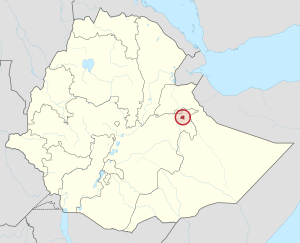Harari Region facts for kids
Quick facts for kids
Harari Region
ሐረሪ ሑስኒ
|
|||
|---|---|---|---|
|
Regional State
|
|||
|
|||

Map of Ethiopia showing Harari Region
|
|||
| Country | Ethiopia | ||
| Capital | Harar | ||
| Area | |||
| • Total | 334 km2 (129 sq mi) | ||
| Population
(2017)
|
|||
| • Total | 246,000 | ||
| • Density | 736.5/km2 (1,908/sq mi) | ||
| ISO 3166 code | ET-HA | ||
The Harari Region is a special part of Ethiopia. It is one of the country's ten regional states. The main city and capital of this region is Harar. This area is the traditional home of the Harari people.
Contents
About the Harari Region
The Harari Region is quite small compared to other parts of Ethiopia. It covers an area of about 334 square kilometers. In 2017, about 246,000 people lived here. It is known for its unique culture and history.
Where is Harari Located?
The Harari Region is located in the eastern part of Ethiopia. It is surrounded by the Oromia Region. The capital city, Harar, is famous for its ancient walled city. This city is a UNESCO World Heritage Site.
Who Lives in Harari?
The main group of people living in the Harari Region are the Harari people. They have their own language, called Harari. This language is part of the Semitic language family. Many other ethnic groups also live in the region. These include the Oromo, Amhara, and Somali people. This mix of cultures makes the region very diverse.
Harari Culture and Traditions
The Harari people have a rich culture. Their traditional homes are often colorful and unique. They are known for their strong community ties. Islam is the main religion practiced by the Harari people. The city of Harar has many mosques and shrines.
How is Harari Governed?
Unlike most other regions in Ethiopia, Harari does not have "zones." Instead, it is divided into smaller areas called woredas. These woredas are like local districts. Each woreda is then divided into even smaller units called kebeles. Kebeles are the smallest administrative divisions.
The woredas in the Harari Region are:
- Amir-Nur Woreda
- Abadir Woreda
- Shenkor Woreda
- Jin'Eala Woreda
- Aboker Woreda
- Hakim Woreda
- Sofi Woreda
- Erer Woreda
- Dire-Teyara Woreda
This system helps manage the region's local affairs. It ensures that services reach all communities.
A Look at Harari's Past
The city of Harar has a very long and interesting history. It was once an important trade center. It connected different parts of Africa and the Middle East. The city was also an independent Islamic state for many centuries. Its strong walls were built to protect it. These walls are still standing today. They tell stories of its rich past.
What Do People Do There?
The economy of the Harari Region is mainly based on trade and agriculture. Coffee is a very important crop grown in the surrounding areas. Many people also work in small businesses. Tourism is growing, especially in the historic city of Harar. Visitors come to see the ancient walls, markets, and unique culture.
See also
 In Spanish: Región Harar para niños
In Spanish: Región Harar para niños



